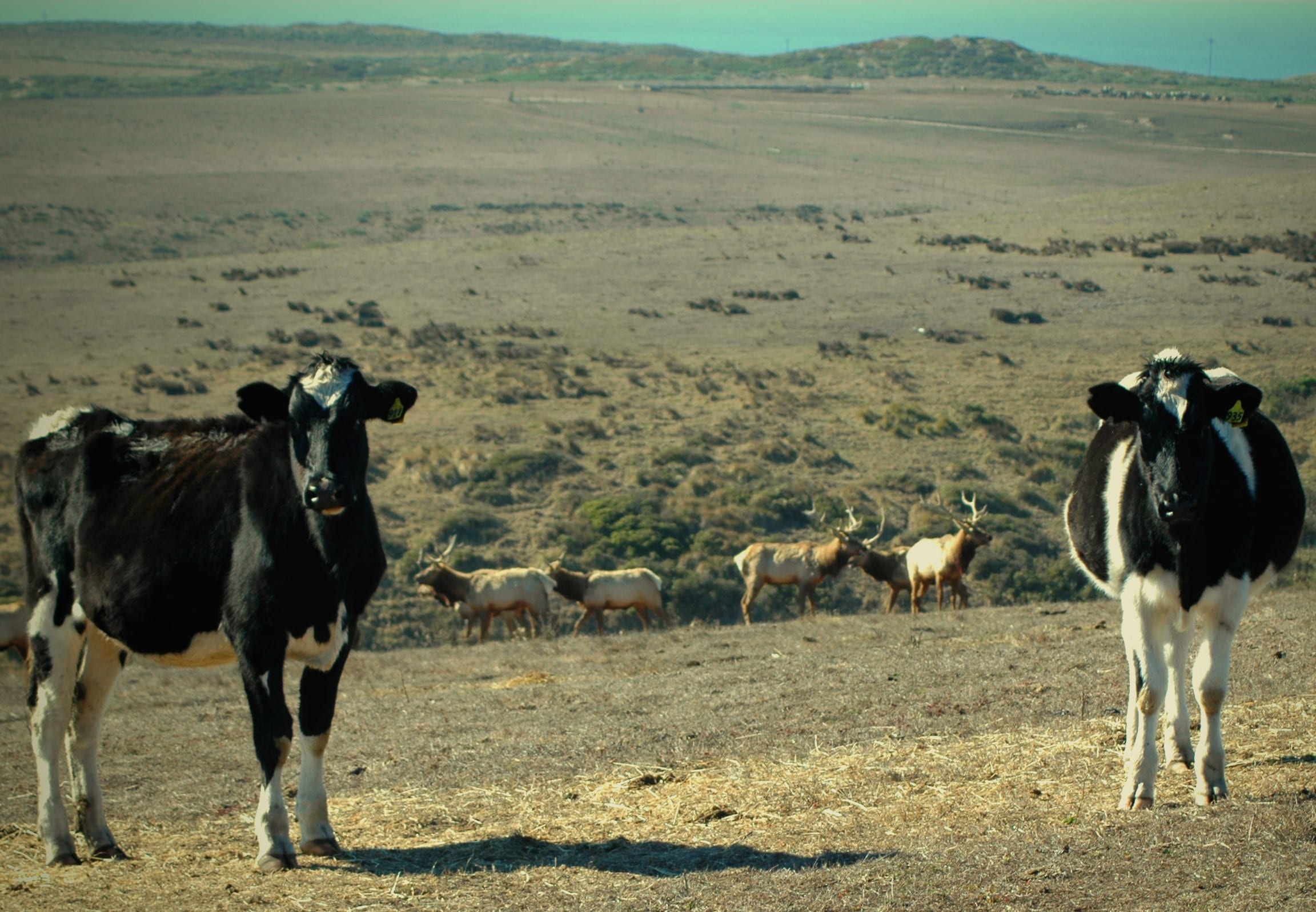
The cows and Tule elk shown here are on the Spaletta’s historic C ranch. Tule elk reintroduced at Point Reyes National Seashore are now being allowed to roam in the pastoral zone, where they are causing damage. Photo by Ann Miller |
On February 10 several radical environmental groups filed a lawsuit in San Francisco Federal District Court against the National Park Service (NPS), seeking a court order to set aside authorizations granted over the past 6 years granted by NPS to ranchers to farm livestock on land at Point Reyes National Seashore (PRNS).1 The suit also claims that NPS should not grant any further authorizations to farm at Point Reyes until the agency first conducts studies, allegedly mandated by law, on the effect the ranching operations conducted there have on the environment. The suit comes a little over a year after NPS and environmental organizations were successful in shutting down Drakes Bay Oyster Company (DBOC), an oyster farm that had operated for 80 years at PRNS.
A spokesperson for NPS made the statement that “ranching is here to stay at Point Reyes National Seashore.”2 Given the evidence, the sincerity of that comment is underwhelming. The court action against NPS does not look like an adversarial lawsuit but rather a wink-wink-nod-nod “friendly” suit. Both plaintiffs in the lawsuit and NPS would like to see all farming at Point Reyes shut down. In fact, Phyllis Faber, former board member of the Point Reyes National Seashore Association, has heard about NPS’s goals firsthand. As a cooperating association, it was formed in 1964 to help NPS preserve and enhance the seashore’s natural, cultural and recreational resources.
In a 2014 story in the Pt. Reyes Light, Faber recounted how Don Neubacher, a former superintendent of the Point Reyes National Seashore, told her years ago that NPS had a “plan” to get rid of all working ranches at the seashore. Neubacher indicated that the “plan would start with closure of the oyster farm in Drakes Estero. Once it was gone, the park [NPS] would stand by as environmental groups brought lawsuits against the surrounding ranches, claiming their operations were degrading water quality. The ranchers, whose means were modest, would have no choice but to shut down, bringing an end to the 150-year ranching tradition at Point Reyes.”3
Further evidence of NPS’s intent can be found in the agency’s “management” of the Tule elk population at the seashore. NPS reintroduced the elk to Point Reyes in 1978; the species hadn’t been at PRNS for well over one hundred years. Until around 2002, NPS monitored the elk population to make sure it did not interfere with cattle ranches in the park but then stopped its management of the elk population. As a result, the elk migrated into the “pastoral zone” which is the 18,000-acre area of the park that the cattle ranchers lease. The elk are known carriers of Johne’s disease, a serious disease transmissible to cattle. Since the elk have moved into the pastoral zone, they have knocked down fences, wrecked irrigation equipment and have been eating forage on land for which the ranchers are paying rent. NPS has done nothing to move the elk out of the pastoral zone.
In 2012, then-Secretary of the Interior Ken Salazar issued a memorandum authorizing NPS to pursue extending 20-year leases to ranchers in the pastoral zone.4 NPS has yet to issue any 20-year leases since the Salazar memo; the letters of authorization NPS has given ranchers have been lease renewals for 5- and 10-year periods (the original leases issued in the 1970s were for 25 years or the life of the owner or the owner’s spouse5). There is a statement in a Park Services 2006 Management Policy document declaring that the agency “will phase out the commercial grazing of livestock whenever possible.”6
The environmental groups filing suit against NPS are the Resource Renewal Institute, the Center for Biological Diversity, and the Western Watersheds Project. Huey Johnson, president of the Resources Renewal Institute, said that the number of cattle in the park (currently 6,000) should be reduced in half.7 That is the short-term goal; the long-term plan is to eliminate ranching at Point Reyes. He added that if the coalition is successful then “the coalition plans to try to reduce or remove livestock from some of the roughly 30 other national parks that allow grazing…” He referred to these operations as “welfare ranching.”8
Congress established the Point Reyes National Seashore in 1962 with the intent of having ranching, oyster farming and the wilderness area co-exist. Ranchers and environmentalists joined together to help create the National Seashore and prevent the land from being developed. NPS shut down oyster farming through falsifying data about the “harm” DBOC was doing to the environment. It looks like it will be mainly the environmental groups doing the work this time around to get rid of the ranchers at Point Reyes—ranchers who have been environmentally-conscious stewards of the land; the vast majority of the land in the pastoral zone is certified organic. The community in the area is tired from the battle over DBOC but they have another fight on their hands if they want to preserve the agricultural heritage of the park.
Footnotes
1 Complaint (Administrative Procedure Act Case). Resource Renewal Institute, Center for Biological Diversity, and Western Watersheds Project v. National Park Service and Cicely. Date Filed: February 10, 2016. pp. 32, paras. 121-125
2 Paul Rogers, “Point Reyes: Lawsuit Challenges Historic Ranching Operations at Iconic Park,” San Jose Mercury News, February 11, 2016. Para. 12 Posted online at http://www.mercurynews.com/science/ci_29504013/point-reyes-lawsuit-challenges-historic-ranching-operations-at
3 Phyllis Faber, Dr. Laura Watt and Peter Prows, “The Plan to Get Rid of the Ranchers,” Point Reyes Light, January 9, 2014. Posted online at http://www.ptreyeslight.com/article/plan-get-rid-ranchers-0
4 Complaint – page 27, para. 101
5 Complaint – page 12, para. 38
6 Complaint – page 14, para. 49
7 Paul Rogers, para. 7
8 Ibid., para. 8
YOUR FUND AT WORK
 Services provided by FTCLDF go beyond providing legal representation for members in court cases.
Services provided by FTCLDF go beyond providing legal representation for members in court cases.
Educational and Political Action Services also provide an avenue for FTCLDF to build grassroots activism to create the most favorable regulatory climate possible. In addition to advising on bill language, FTCLDF supports favorable legislation via action alerts, social media outreach, and the online petition service.
You can help FTCLDF by becoming a member or donating today.

 Anyone wanting to make a contribution to support the work of FTCLDF can make a donation online or send a check to:
Anyone wanting to make a contribution to support the work of FTCLDF can make a donation online or send a check to:
FTCLDF
8116 Arlington Blvd, # 263
Falls Church, VA 22042
Prefer to make a tax-deductible donation? Donate online at bit.ly/NFG4FTC.
You may also contact us by email at [email protected] or call 703-208-FARM (3276). Thanks for your support.